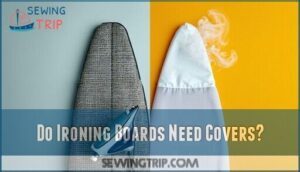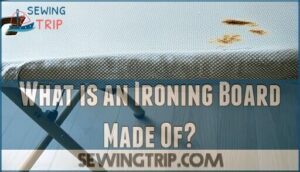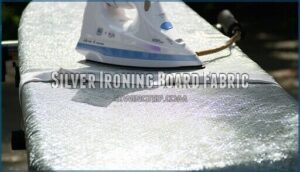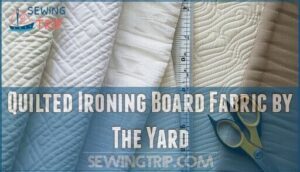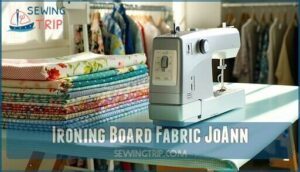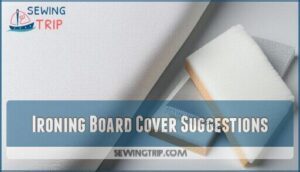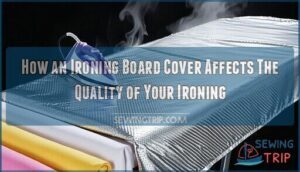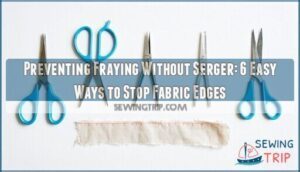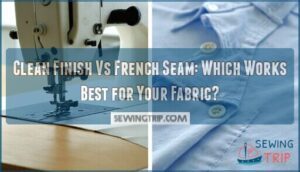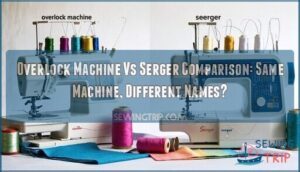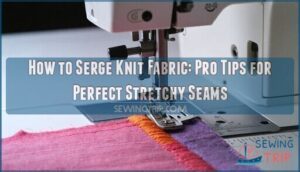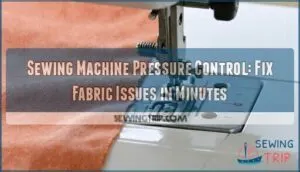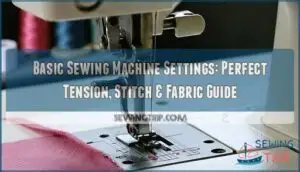This site is supported by our readers. We may earn a commission, at no cost to you, if you purchase through links.
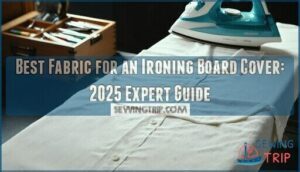 Cotton and Teflon are the best fabrics for an ironing board cover because they handle heat like champs while protecting your clothes.
Cotton and Teflon are the best fabrics for an ironing board cover because they handle heat like champs while protecting your clothes.
Cotton breathes well and won’t scorch your favorite shirt, while Teflon’s non-stick surface makes gliding effortless.
Both materials grip fabric just right—not too much, not too little—so you’re not wrestling with slippery silk or sticky synthetics.
Avoid polyester blends that melt under pressure and create shiny spots on delicate fabrics.
The right cover transforms your ironing from a chore into smooth sailing with smart fabric choices and proper padding, and strategic features can turn even the most stubborn wrinkles into submission.
Table Of Contents
- Key Takeaways
- DIY Ironing Board Cover
- Do Ironing Boards Need Covers?
- What is an Ironing Board Made Of?
- What Padding Do You Use on an Ironing Board?
- Best Fabric for an Ironing Board Cover
- Silver Ironing Board Fabric
- Quilted Ironing Board Fabric by The Yard
- Ironing Board Fabric JoAnn
- Ironing Board Cover Suggestions
- How an Ironing Board Cover Affects The Quality of Your Ironing
- Frequently Asked Questions (FAQs)
- Conclusion
Key Takeaways
- Choose cotton or Teflon covers – Cotton breathes well and won’t scorch your clothes, while Teflon’s non-stick surface makes ironing effortless and prevents fabric from sticking
- Avoid polyester blends – They’ll melt under high heat and create permanent shiny spots on your delicate fabrics that you can’t remove
- Add proper padding underneath – Use cotton batting or wool felt to create a smooth, cushioned surface that prevents heat damage and fabric impressions
- Consider your ironing style – Cotton provides better grip for controlling fabrics, while Teflon’s slippery surface works best if you prefer smooth gliding motions
DIY Ironing Board Cover
Creating your own ironing board cover transforms both function and style in your laundry space.
Start with fabric sourcing from the utility section of fabric stores, choosing heat resistant fabric like cotton canvas or duck cloth.
These materials handle high temperatures without scorching or melting. For padding alternatives, layer 100% cotton batting beneath your chosen fabric.
This creates the perfect cushioning while allowing steam to pass through effectively. When securing methods are your focus, measure carefully and cut elastic to fit snugly around your board’s edges.
Hand-sew elastic channels with reinforced stitching for durability. This DIY approach lets you experiment with cover patterns that match your décor.
Custom embellishments like quilted textures or painted designs add personal flair. For added protection, consider the importance of fabric preparation.
Fabric selection becomes an art form when you’re choosing colors and patterns. Teflon-coated options provide non-stick benefits, while traditional cotton offers reliable performance.
Your handmade ironing board cover demonstrates attention to detail that elevates everyday chores.
Do Ironing Boards Need Covers?
Your ironing board absolutely needs a cover – it’s not optional equipment. Without one, you’ll struggle with uneven surfaces, heat damage, and poor results that’ll make you want to throw your iron out the window.
A bare ironing board is your enemy – it creates wrinkles instead of removing them.
Here’s why every ironing board demands proper surface protection:
- Heat reflection prevents your iron from losing temperature to the bare board
- Steam escape allows moisture to pass through instead of creating soggy spots
- Ironing efficiency improves dramatically with the right heat resistant fabric
- Extend lifespan of both your board and clothes by preventing direct contact
The right ironing board cover transforms a basic metal frame into a professional ironing surface material. Quality ironing board fabric with proper ironing board padding creates that smooth glide you need for wrinkle-free results.
To prevent issues, consider adding extra padding beneath the cover. Think of it like trying to write on a rough wooden table versus smooth paper – the cover is your smooth paper. Without it, you’re fighting the surface instead of working with it. Your clothes deserve better than a bare metal wrestling match.
What is an Ironing Board Made Of?
Quality ironing boards typically feature metal frames with perforated steel tops.
Steel vs. wood construction matters – steel handles heat better and won’t warp.
The perforated surface lets steam escape while providing stability.
Frame materials like heavy-gauge steel offer durability, while wooden legs add balance with non-slip feet for stability.
Heat resistance becomes critical when selecting your ironing surface material.
Most ironing board materials pair with cotton or wool covers that naturally resist scorching.
Proper ironing board padding underneath prevents garment impressions during pressing sessions.
Many quilters prefer boards with a wide ironing surface for larger fabric pieces.
What Padding Do You Use on an Ironing Board?
Understanding your ironing board’s construction helps you choose the right padding for ideal performance.
The padding layer sits between your board’s surface and cover, creating a smooth foundation that prevents heat damage and fabric impressions.
Here are the top padding options for your ironing board:
- Cotton batting – Your best choice for heat resistance and durability, available at most craft stores
- Wool felt – Premium option that provides excellent cushioning but costs more than cotton alternatives
- Cotton batt – Budget-friendly alternative using old cotton blankets or quilting scraps
- Synthetic alternatives – Avoid polyester batting and foam, which can melt under high temperatures
Layer thickness matters substantially for heat protection.
Most manufacturers recommend four layers of material to prevent heat penetration through to your board’s surface.
Some users find that using an extra wide board helps when ironing larger items.
Cotton batting naturally absorbs moisture and resists scorching, making it ideal for steam ironing.
Watch out for older boards with asbestos-lined pads – these pose serious health dangers and need immediate replacement.
When selecting padding, stick with natural fibers that won’t deteriorate under heat.
Proper padding prevents those annoying fabric impressions that show up on freshly pressed clothes.
Best Fabric for an Ironing Board Cover
Performance matters when you’re pressed for time, and choosing the right ironing board fabric makes all the difference. Cotton duck or canvas delivers the gold standard for ironing board covers due to superior heat resistance and durability. These natural fibers withstand scorching temperatures while providing the grip you need to keep fabrics in place.
Your fabric choice transforms every iron stroke from struggle to success.
**Fabric weight substantially impacts performance.
** Look for medium-weight cotton in the 10-12 oz range – it’s sturdy enough to handle repeated high-heat sessions without breaking down. Weave density also matters; tightly woven fabrics create smoother surfaces and resist wear better than loose weaves.
**Heat resistant fabric options extend beyond basic cotton.
** Cotton ironing covers with Teflon coating offer enhanced stain resistance, while scorch resistant covers provide extra protection during high-temperature work. Some crafters prefer heat reflective fabric for efficiency, though pure cotton remains most reliable.
**Synthetic options exist but proceed cautiously.
** Polyester blends cost less but may melt under extreme heat. Natural fibers like 100% cotton absorb moisture effectively while maintaining structural integrity, making them the safest choice for consistent results. Silicone-coated fabric is another durable cover material that can be used.
Silver Ironing Board Fabric
When silver fabric meets your ironing board, you’re investing in efficiency that comes with trade-offs.
This heat reflective fabric delivers impressive performance through its aluminized coating, but understanding its characteristics helps you make the right choice.
Here’s what you need to know about silver ironing board covers:
- Heat reflection – Silver fabric reflects up to 300% more heat back onto garments, cutting ironing time substantially
- Slippery fabrics – The smooth metallic surface lets clothes glide effortlessly, though some find it too slick
- Durability concerns – Silver degradation occurs over time, with the coating showing wear after heavy use
- Cost analysis – Higher upfront investment compared to cotton, but heat-resistant materials often pay off through efficiency
The metallized layer creates a super-smooth ironing surface that stays cooler to touch.
Many DIY enthusiasts also consider canvas fabric options for their ironing boards.
While silver fabric offers professional-grade performance, consider whether the slippery surface suits your ironing style before committing to this metallic ironing cover.
Quilted Ironing Board Fabric by The Yard
When you’re ready to upgrade from basic silver fabric, quilted ironing board fabric by the yard offers superior construction and performance. This pre-quilted material combines 100% cotton with heavy cotton batting in diamond patterns, creating a professional-grade surface that’s scorchproof up to 390°F.
Quilting techniques bind multiple layers together, ensuring durability while fabric varieties range from canvas to cotton duck. These stitch patterns prevent shifting and maintain consistent padding thickness. You’ll find color combinations from classic white to decorative prints, letting you customize your workspace.
For quilters, a wide ironing surface is essential for pressing large quilt sections. Cover longevity improves dramatically with quilted construction. The integrated padding eliminates bunching while sewing projects benefit from the stable surface.
| Feature | Standard Quilted | Aluminized Quilted | Pre-Quilted Canvas |
|---|---|---|---|
| Heat Rating | 300°F | 390°F | 350°F |
| Price/Yard | $7.49 | $9.99 | $8.25 |
| Width Options | 42-45" | 45-60" | 42-54" |
| Padding Included | Yes | Yes | Yes |
| Washable | Yes | Gentle Cycle | Yes |
Purchase extra yardage for future replacements, as this can help extend the life of your ironing board and ensure you always have a stable surface for your sewing projects. This approach also allows for customization and can be a cost-effective way to maintain your equipment over time.
Ironing Board Fabric JoAnn
JoAnn’s fabric selection makes creating custom ironing board covers straightforward and affordable.
You’ll find silver ironing board fabric with heat-resistant aluminized coating, plus 100% cotton options like duck canvas and quilting fabrics.
The silver fabric reflects heat effectively but can feel slippery, while cotton duck provides better grip.
Most JoAnn ironing board fabric comes in 42-44 inch widths, perfect for standard boards.
Cotton options offer excellent heat resistance and durability, though they may require pre-washing to prevent shrinkage.
Consider cotton’s breathability properties for a more comfortable ironing experience.
Ironing Board Cover Suggestions
When selecting cover material options for your ironing board, you’ll want to balance functionality with personal style.
Cotton canvas remains the gold standard for fabric for ironing board covers due to its heat resistance and durability.
However, don’t overlook padding alternatives like cotton batting or wool felt, which provide excellent cushioning.
Custom cover designs let you match your laundry room’s aesthetic while maintaining performance.
For reflective properties, consider silver-coated fabrics that bounce heat back to your garments.
For those with larger items, consider that an extra wide board saves time.
When securing the cover, create a proper elastic channel for a snug fit that won’t shift during use.
How an Ironing Board Cover Affects The Quality of Your Ironing
Why does your ironing board cover matter so much for getting professional results? The fabric you choose directly impacts every aspect of your ironing experience, from heat reflection to garment protection.
Your ironing board cover affects ironing quality through several key mechanisms:
- Heat Reflection – Quality heat resistant fabric bounces up to 95% of heat back to your clothes, cutting ironing time by 30%
- Steam Escape – Proper ironing board fabric allows moisture to pass through, preventing water spots and fabric damage
- Surface Smoothness – Thick padding creates an even base that eliminates grid marks from transferring to your garments
- Garment Protection – The right cover acts as a barrier between delicate fabrics and the metal board surface
- Ironing Efficiency – Well-fitted covers with proper padding reduce the number of passes needed for crisp results
Without a proper ironing board cover, you’ll fight against uneven heat distribution, trapped steam, and surface imperfections that make achieving professional-looking results nearly impossible. To prevent these issues, consider adding extra padding to your ironing board.
Frequently Asked Questions (FAQs)
What is the best fabric for ironing board covers?
Before smartphones made us instant experts, choosing fabric was guesswork. You’ll want 100% cotton for your ironing board cover—it’s heat-resistant, breathable, and grips fabric perfectly without slipping or scorching.
How to choose the best ironing board covers & padding?
Choose covers with heat-resistant cotton or cotton duck fabric for grip and durability.
Select wool or cotton felt padding over foam, which can melt.
Verify proper sizing with extra fabric to tuck securely underneath.
Why do you need ironing board covers?
Like a knight’s armor protects in battle, you’ll need covers to shield your ironing board from heat damage.
Prevent fabric slipping on metal surfaces, and create a smooth workspace that won’t snag delicate clothes.
What is a mesh ironing board cover?
Mesh covers feature perforated fabric that allows steam to pass through easily, preventing moisture buildup while you’re ironing. This breathable design helps delicate fabrics stay wrinkle-free without trapping excess heat.
What is a Teflon ironing board cover?
Modern ironing boards handle over 400°F temperatures daily, making heat resistance essential.
A Teflon ironing board cover features a non-stick coating that’s heat-resistant and durable, preventing fabric from sticking during ironing while providing smooth gliding.
What is ironing board fabric?
Ironing board fabric is heat-resistant material designed specifically for covering ironing boards.
You’ll find cotton, polyester, mesh, and Teflon-coated options that protect garments while providing smooth, durable surfaces for effective ironing.
What can I use as an ironing board cover?
Nearly 80% of ironing mishaps stem from inadequate covers, making proper selection essential for your safety and results.
You can use thick cotton towels, canvas drop cloths, or quilted fabric as effective alternatives.
Cotton duck cloth paired with felt padding works brilliantly for DIY covers.
What is the best ironing board cover?
You’ll want heat-resistant cotton covers with thick padding for best results. Look for brands like Bartnelli or TIVIT that offer scorch-resistant materials, secure fastening, and steam-friendly designs for professional ironing.
What is the best thickness for ironing board cover?
You’ll want a cover that’s about 4-6mm thick for ideal performance.
This thickness provides enough cushioning without being too bulky, allowing steam to pass through while creating a smooth ironing surface that won’t interfere with your technique.
What is the best cloth for ironing?
Cotton stands as your best choice for ironing clothes.
It’s breathable, heat-resistant, and provides excellent grip to prevent fabric slipping.
Cotton absorbs moisture naturally while resisting scorching, making it superior to synthetic alternatives for achieving crisp, professional results.
Conclusion
Surprisingly, choosing the best fabric for an ironing board cover affects your laundry results more than you’d think.
Cotton and Teflon stand out as top performers, handling heat without scorching while providing smooth gliding action.
Cotton breathes naturally and grips fabric properly, while Teflon’s non-stick surface prevents sticking and burning.
Skip polyester blends that melt under heat and create permanent shine marks.
Your fabric choice transforms ironing from tedious chore into efficient task, delivering professional results every time.

